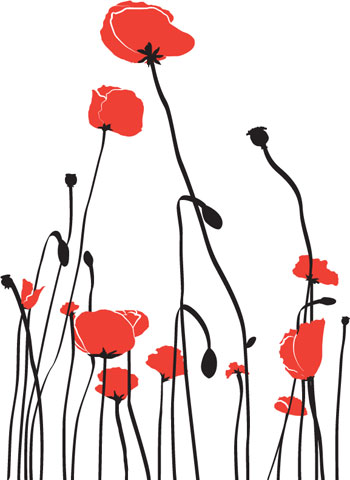The Book of the Poppy
Read The Book of the Poppy Online
Authors: Chris McNab



CONTENTS

Vice Admiral Peter Wilkinson, CB CVO
National President, The Royal British Legion
In Flanders fields the poppies blow
Between the crosses, row on row …
John McCrae
POPPIES, WHICH GROW
abundantly in northern France and which were commented upon by many of the soldiers fighting there, were suggested as a symbol of Remembrance to mark the enormous human cost of the First World War following the publication of John McCrae’s poem ‘In Flanders Fields’. They were adopted by the American Legion in 1920 and a year later by the newly formed British Legion, as the emblem for its first fundraising campaign, now known everywhere as the Poppy Appeal.
The 4th of August 2014 marks the 100th anniversary of the day Britain entered the First World War – one of the costliest conflicts in history. This book will provide you with an understanding of the history of the poppy and its significance as a unique and enduring symbol that represents the Legion’s vital work for the Armed Forces community.
Nearly a century on, that work is more important than ever. The problems faced by serving personnel, veterans and their dependents today are very similar to those that faced soldiers returning from the First World War; whether living with bereavement or disability, finding employment, or coping with financial stress. The Legion is currently spending £1.6 million each week to provide vital care and support to the Armed Forces community and we intend to be here for the next 100 years to ensure that the needs of all our beneficiaries continue to be met.
Thank you for purchasing
The Book of the Poppy
. It is with great pleasure, respect and gratitude that I, as National President of The Royal British Legion, invite you to join me in reflecting on what the poppy has meant to past generations and what it still means to us today.
Vice Admiral Peter Wilkinson, CB CVO
National President, The Royal British Legion
WAR HAS UNDENIABLY
shaped Britain, historically and socially. For there have been relatively few prolonged periods in British history when the nation has not been embroiled in domestic or foreign conflict. These conflicts have cost the lives of millions of soldiers and thousands of civilians, blood being spilt in every corner of the globe across the centuries. Yet this constant immersion in conflict does not seem to have stripped the nation of its humanity. Indeed, it is a somewhat warming truth that in many ways we have become more, not less, reflective on the nature of conflict and its human cost.
Every year in the United Kingdom, in October and running into November, a distinctive accessory is attached to the clothing of millions of people. This accessory is unusual in that it isn’t about fashion, nor is it purely about fundraising (although this is a major part of the rationale behind its distribution). Instead, it is a very visible national act of commemoration. It is the Remembrance Poppy.
In its typical form, the Remembrance Poppy is not an item of material worth. It is basically a poppy rendered in paper and plastic, the vivid red paper petals standing out clearly and attractively atop a green plastic stem. And yet, there are few items worn with more reflection and pride. It represents a collective act of remembrance for generations of British war dead, especially the nation’s military personnel. At the same time it also compels us to think about all those who have died in conflict, including Britain’s former enemies, and those who continue to suffer the effects of war, whether veterans of previous conflicts or victims of present ones. In many ways, therefore, each poppy represents not just loss, but the continuing desire to care for those affected by war.
This short book is published to coincide with the centenary of the beginning of the First World War (1914–18). A hundred years ago, a shot rang out on the streets of Sarajevo, the assassin’s bullet inflicting mortal wounds on the Austro-Hungarian Archduke Franz Ferdinand. Four years later, through a scarcely conceivable chain reaction of events, 20 million people lay dead and large parts of Europe, Africa and the Middle East were in ruin. The magnitude and human cost of this conflict still reverberate today, even in light of the subsequent world war between 1939 and 1945, which killed more than 50 million. Furthermore, the end of the Second World War did not see an end to global conflict – sadly there has not been a single year since 1945 in which war has not been fought somewhere around the globe. British soldiers have continued to fight, die and endure to the present day. The Remembrance Poppy, therefore, has never been more relevant.
Chris McNab, 2014

IT IS UNDENIABLE
that Britain has a particularly distinguished military history and martial tradition. What is often remarkable about this history is that is has generally been achieved with a comparatively small armed forces. Looking back to the medieval age, the martial burden of the nation was taken by a militia – a non-professional citizen army. Various royal statutes placed obligations for male citizens to serve in the militia at times of crisis, led by the noble knights who owed feudal service to the king or queen. There were very few of what we would know as ‘standing forces’ (full-time professional soldiers) – isolated examples include the Yeoman of the Guard, essentially a professional royal bodyguard force created by Henry VII in 1485 at the Battle of Bosworth Field. It should also be noted that the medieval monarchs drew heavily upon foreign mercenaries to patch the gaps in military capability – Britain’s armies have frequently been international bodies.
The soldiers of the medieval militias were kept busy through an endless sequence of destructive wars, from bitter civil conflicts such as the War of the Roses (1455–1487) to distant expeditionary adventures like the Crusades in the Middle East. Hundreds of thousands of British citizens served and died for causes truly remote from their daily lives and concerns, although the ferocity with which they fought gave the British renown as a warrior race.
The nature of Britain’s armed forces changed considerably during the sixteenth and seventeenth centuries, not least in terms of maritime power. By the sixteenth century, the nation had already established a ‘Navy Royal’, a force of State-owned warships and naval facilities. The size and power of the force waxed and waned, the British fleet often supplemented by private vessels to fight its wars. Crises were averted, such as the repulsion of the Spanish Armada in 1588 (as much by virtue of the resistant British weather as its navy), but as an island nation Britain needed a more formidable fleet. This ambition was realised in the seventeenth century, as the Navy Royal expanded under both Charles I (r. 1625–49) and II (r. 1660–85) and the rule of Oliver Cromwell/the Commonwealth that separated the kings’ rule. Through major programmes of shipbuilding, fuelled by conflicts such as the Third Anglo-Dutch War (1672–74) and the War of the Grand Alliance (1688–97), Britain acquired a ‘Royal Navy’ and became the most powerful naval force on the planet for the next 200 years.
The army was also changing. Queen Elizabeth’s long-running war against the Spanish in the Netherlands from 1595 demanded huge amounts of manpower. Although still using the militia system, Elizabeth oversaw a degree of professionalisation of the army, particularly in terms of command and administration, but it still didn’t give Britain a stable force. Ironically, it took revolution to transform Britain’s land forces. Following the overthrow and execution of Charles I, Oliver Cromwell’s ‘New Model Army’ became Britain’s first professional standing army. It was well-trained, liable for service in any destination (previously many militias had just been bound to service in a single local area) and had a professional officer class. Although the Commonwealth collapsed in 1660, with the restoration of Charles II, the new monarch saw the clear value of a standing army, and began to build up his own. This army swelled rapidly – it reached about 40,000 men strong under James II (1685–88) – and was structured around a regimental system that still exists today. This system, which first emerged in the sixteenth century, created formations of soldiers with a fierce sense of local identity and geographical connection. (The practice of creating county, as opposed to numbered, regiments was actually implemented by Richard Haldane, the British Secretary of State for War between 1905 and 1912.)
By the time Britain had a standing army, the nature of warfare had changed almost beyond recognition compared to the medieval period. Gunpowder was now a force on the battlefield. Crude cannon and ‘hand-gonnes’ (effectively the first small-arms) had been introduced into Europe in the fourteenth century. As the weapons developed in power and dependability, they had a fundamental impact on the social and political fabric of the nation. The castle, the traditional seat of noble power, could now be cracked open by gunpowder artillery (although this process still required some thunderous persistence) and humble infantry armed with musket firearms could kill the most esteemed knight, despite having just days training as opposed to the years required to create a professional archer. By the seventeenth century, the muskets were using flintlock mechanisms that gave faster and consistent volley fire, while the artillery was more mobile and devastating, wheeled into position on the battlefield to deliver terrible hails of solid ball and grape shot. Although much killing was still done at close quarters with bayonet and blade, now the bulk of the slaughter was performed at a distance by gunpowder weaponry.
Britain’s professional military units were certainly kept busy during the eighteenth and nineteenth centuries. Following the 1707 Act of Union between England and Scotland, the land forces were a truly ‘British Army’, and under leaders such as Marlborough and Wellington it became (and remains) a globally respected force. It was ever more international in its involvements, participating in coalition conflicts such as the War of the Spanish Succession (1701–14), the Seven Years’ War (1754–63) and the Napoleonic Wars (1803–15). At the same time, the British established the largest empire the world had ever seen, so thousands of men found themselves deployed to truly remote corners of the world, effectively as imperial police forces.
